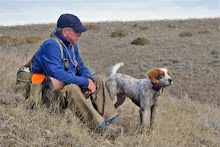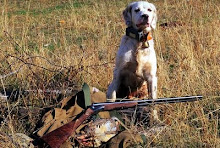I have several of Horace Lytle's books (Horace being the dog editor for Field & Stream for many years and, at least one time, a judge of the National Championship), but had never explored his Breaking a Bird Dog (1923) or How to Train a Bird Dog (1932). I knew Bill Brown's Field Trials: History, Management, and Judging Standards (1947) and have even been lucky to find a copy of its precursor, The Field Trial Primer: A Valuable Book for Field Trial Fans (1934). The title of the latter, in particular, is a sunny insight into how the sport was perceived in the glory days between the World Wars. But I didn't know that Bill Brown had written his own training book, How to Train Hunting Dogs (1942) -- and was excited to find a copy to see what gems might lie in there, too. But this post isn't about the things I learned from the book, but the funny threads of time that tie us back to the great men, women, and dogs that came before us.
When I bought it, I knew the book was signed by Brown, but had no idea what else was in there. There is no date that goes with the inscription in the book, although being from only its second printing run in 1943, part of me really wants it to have been from the 1940s. Nevertheless the inscription reads: "To my friend John Gardner, who knows many expert things about training bird dogs not contained in this book." I want to imagine that the book was dedicated to the professional trainer and field trial handler in the 1940s, three decades before he would find his 'One' -- in fact, three decades before John Gardner and Miss One Dot would find themselves on the back steps of the Main House at Ames, the national championship winners for 1979. I haven't been able to track down the exact information and correlate it, but at the time John Gardner and Miss One Dot were reputedly both the oldest competitors to win the National Championship. Their story together is mythologized in the fanciful The Old Man...And the Dog (1984) written by Carroll Seabrook Leatherman, Dot's owner -- but however told, that Dot survived being almost stillborn, snakebites, and a plane crash, and then won the National aged eight is still pretty remarkable. Her trainer and handler is commemorated every year at the National when the equivalent of the green golf Master's jacket, the John Gardner Memorial Coat, is presented to the owner of the winning dog.
*******
While this is a little out-of-phase, while thumbing through Bill
 Brown's Field Trials, I came across two separate pictures of two dogs, Norias Roy and Norias Aeroflow. Roy won the National Free-for-All in 1933; and while the picture of Aeroflow shows the brace-off at the 1940 National Free-for-All in which he was ultimately beaten by Rockabye Baby, he had already won that championship in 1938. But like I said, this is a little out-of-phase.
Brown's Field Trials, I came across two separate pictures of two dogs, Norias Roy and Norias Aeroflow. Roy won the National Free-for-All in 1933; and while the picture of Aeroflow shows the brace-off at the 1940 National Free-for-All in which he was ultimately beaten by Rockabye Baby, he had already won that championship in 1938. But like I said, this is a little out-of-phase.Inspired by an anecdote in Bill Allen's The Unforgettables and Other True Fables (2010), a collection of myths, legends, and memories from his four decades as a reporter for the American Field, I realized that I had only one degree of separation from the owner of Roy, Aeroflow, as well as that of Norias Annie (who won the National Championship in 1934) and Mary Blue (who won the National Championship in 1929 and 1931 and between those, the National Free-for-All in 1930). The prefix 'Norias' denotes the original Norias plantation in northeastern Leon County, Florida, originally purchased by a nine-man syndicate that included the then-governor of New Jersey, Walter Edge, and also Walter Clark Teagle. Whether his connection to the King Ranch was also as a result of a hunting trip, Teagle apparently named the plantation Norias after the origin point for one of Standard Oil's new pipelines from Texas to New Jersey. Each of the other partners eventually sold their shares in Norias to Teagle, ultimately collecting approximately 19,000 acres as a private hunting reserve.
I was lucky to have lunch with one of Walter Teagle's relatives recently who shared some of these details with me. However, one additional thing he did share was the moderately amusing story of finding various poultry trophies in a family closet. As is evident from his list of champions, his choice of Chesley Harris as his trainer and handler, and the acquisition of Norias, Walter Teagle followed his passions to the fullest. He was also an avid salmon fisherman and, as it turned out, the trophies were the glorious by-product of raising roosters that had the best feathers for tying his own flies with.
He did also tell me that Mary Blue was an odd dog. While Chesley Harris was apparently fond of the fact that she was a dog with both seemingly endless endurance and tremendous focus, I had already presumed that the reason she might not have already been elected to the Hall of Fame
 was because she was not a prominent producer. And that was because she was apparently a murderous mother. Her seemingly favorite litter was the result of a backstreet affair with a plantation Labrador and which she guarded fiercely, the pups going on to be quite accomplished hunting dogs. This portrait of her graced the cover of Time Magazine for the March 3rd, 1930, edition in an article that speculated whether Mary Blue could repeat her win from the year before -- or indeed whether a pointer would be beaten by a setter. Chesley Harris is indirectly quoted as saying that "when it came to field trials, he wanted to see Mary Blue, after four hours on a wide range, point her last single; a pale liver-spotted statue of a dog, outlined in arrested motion against the background of Japanese clover and the rolling country of the Old Hancock Place." (p.61)
was because she was not a prominent producer. And that was because she was apparently a murderous mother. Her seemingly favorite litter was the result of a backstreet affair with a plantation Labrador and which she guarded fiercely, the pups going on to be quite accomplished hunting dogs. This portrait of her graced the cover of Time Magazine for the March 3rd, 1930, edition in an article that speculated whether Mary Blue could repeat her win from the year before -- or indeed whether a pointer would be beaten by a setter. Chesley Harris is indirectly quoted as saying that "when it came to field trials, he wanted to see Mary Blue, after four hours on a wide range, point her last single; a pale liver-spotted statue of a dog, outlined in arrested motion against the background of Japanese clover and the rolling country of the Old Hancock Place." (p.61)Nevertheless, Norias and his pursuit of the finest trial dogs of the day were not merely a wealthy man's amusements. I don't know if Teagle was inspired by the brothers, Richard and Robert Kleberg, Jr., or their nephew, Caesar Kleberg (who happened to live in the Norias division of the King Ranch), but by the first decade of the 20thC and as a result of unrestrained hunting and a series of catastrophic droughts game populations for several species were severely depleted on the King Ranch. Between them, the three Klebergs instituted a number of measures including limiting hunting seasons, establishing bag limits and, interestingly, requiring quail hunters to have good retrievers, not covey shoot, and ideally use a 20ga or less. Richard Kleberg is also credited with being the person responsible for the creation of the federal Migratory Bird Hunting Stamp Act in 1934 (the 'duck stamp') which has funded the acquisition and preservation of over 4.5million acres of wetland since the Act's adoption. By the 1920s, quail populations in the Red Hills region of southern Georgia and northern Florida had also plummeted to record lows and it was clear to Teagle and others that some kind of systematic game management approach had to be developed to ensure that bobwhite quail, amongst others, rebounded and continued to thrive.
For most of us who read this blog, I figure that the most prominent evidence most of us might have for their kind of comprehensive approach to preserving game birds is also on our bookshelves. While he had already independently compiled ecological inventories at Norias and directly solicited expert information from the USDA and Department of the Interior, Teagle joined a coalition of plantation owners (including Colonel Lewis Thompson of Sunny Hill and Arthur Lapsley of Meridian) to hire naturalist Herbert Stoddard to study the decline and offer remedies. Based on six years of research, the Committee on the Cooperative Quail Investigation (as the coalition was known) published Stoddard's foundation-building The Bobwhite Quail, Its Habits, Preservation, and Increase in 1931. While Walter Teagle seems to have been one of the lesser members of the Committee, Norias is nevertheless credited as being the location for one of the first sites for experimenting with breeding and hatching quail in a controlled setting. In short, Walter Teagle's legendary quest for perfection not only produced first-rate field trial dogs that left their mark on our sport but also contributed to the kinds of responsible game management that continue to make our sport possible.









2 comments:
Brilliant Andrew. That was a spectacular lesson in history of the sport and conservation. Thank you, Jared
Andrew
Outstanding find! And thanks for the history lesson. Trialing bird dogs is a small world, it seems.
Post a Comment